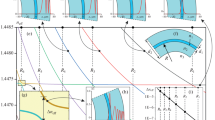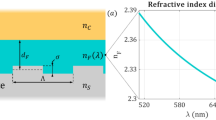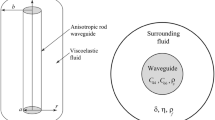Abstract
Wave propagation through curved bends in integrated optical waveguides is governed by the evanescent field and the radiation loss of the eigenmodes. Since these parameters are influenced by the refractive index of the surrounding medium, circular bends in rib waveguides have been successfully employed as chemical sensors for liquids and gases. In this paper the electromagnetic field, the refractive index and the radiation loss of the eigenmodes are precisely determined by a fully vectorial approach based on the method of lines. An axial discretization and Bessel functions of complex order are employed for the rigorous computation of the evanescent field. The intensity distributions of the first modes in a rib waveguide are presented. The influence of the rib height on the sensitivity of the modal index to the refractive index of the surrounding medium is investigated. The results are useful for the optimization of the sensor design.
Similar content being viewed by others
References
Abramowitz, M. and I.A. Stegun. Handbook of Mathematical Functions, Chap. 9. Dover Publ., New York, 1965.
Collin, R.E. Field Theory of Guided Waves, 2nd edn. IEEE press, New York, 1991.
Diestel, H. IEEE J. Quant. Electron. QE 20 1288, 1984.
Gu, J.S., P.A. Besse and H. Melchior. IEEE J. Quant. Electron. 27 531, 1991.
Kim, S. and A. Gopinath. J. Lightwave Technol. 14 2085, 1996.
Lewin, L., D.C. Chang and E.F. Kuester. Electromagnetic Waves and Curved Structures. Chaps. 8–9, p. 95. Peter Peregrinius, Stevenage, UK, 1977.
Pascher, W. and R. Pregla. Proc. Int. Conf. on Integrated Optics and Optical Fibre Communications: Analysis of Curved Optical Waveguides by the Vectorial Method of Lines, p. 237. Paris, France, 1991.
Pascher, W. and R. Pregla. Radio Sci. 28 1229, 1993.
Pregla, R. and W. Pascher. In: The Method of Lines, ed. T. Itoh, p. 381. J. Wiley Publ., New York, USA, 1989.
Pregla, R. J. Lightwave Technol. 14 634, 1996.
Rogge, U. and R. Pregla. J. Opt. Soc. Am. B 8 459, 1991.
Van Dam, C., H. Heidrich, M. Hamacher, C. Steenbergen, M. Smit and C. Weinert. Philips patent nr. 15.544, Appl. nr. 95202957.7, 1995.
Van Dam, C. et al. IEEE Photon. Technol. Lett. 8 1346, 1996.
Van Dam, C. InP-based Polarisation Independent Wavelength Demultiplexers, PhD Thesis, TU Delft, The Netherlands, 1997.
Vassallo, C. Optical Waveguide Concepts, Elsevier, Amsterdam, NL, 1991.
Veldhuis, G.J. and P.V. Lambeck. Appl. Phys. Lett. 71 2895, 1997.
Yamamoto, T. and M. Koshiba. J. Lightwave Technol. 11 1579, 1993.
Author information
Authors and Affiliations
Rights and permissions
About this article
Cite this article
Pascher, W. Modelling of rib waveguide bends for sensor applications. Optical and Quantum Electronics 33, 433–449 (2001). https://doi.org/10.1023/A:1010847018034
Issue Date:
DOI: https://doi.org/10.1023/A:1010847018034




